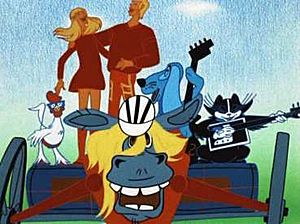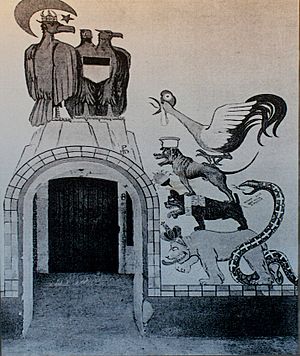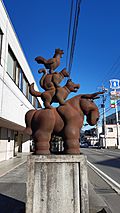Town Musicians of Bremen facts for kids
Quick facts for kids Town Musicians of Bremen |
|
|---|---|

A bronze statue by Gerhard Marcks depicting the Bremen Town Musicians located in Bremen, Germany. The statue was erected in 1953.
|
|
| Folk tale | |
| Name | Town Musicians of Bremen |
| Data | |
| Aarne-Thompson grouping | ATU 130 (The Animals in Night Quarters) |
| Country | Germany |
The Town Musicians of Bremen (German: Die Bremer Stadtmusikanten) is a famous German fairy tale. The Brothers Grimm collected and published it in their book Grimms' Fairy Tales in 1819.
The story is about four old farm animals. They worked hard their whole lives. But then, their owners treated them badly. So, they decided to run away. Their plan was to become musicians in the city of Bremen.
However, the animals never actually reach Bremen! Instead, they trick some robbers. They scare the robbers away from their house. The animals then take over the house and live there happily. This tale is known as an "Outcast animals find a new home" type of story.
Contents
Story's Beginning
The Brothers Grimm first shared this tale in 1819. It was part of the second edition of their book, Kinder- und Hausmärchen. They heard the story from a German storyteller named Dorothea Viehmann.
What Happens in the Story
The story features a donkey, a hound (dog), a cat, and a rooster. They were all getting old. Their owners thought they were no longer useful. They were about to be gotten rid of or treated poorly.
One by one, they left their homes. They all decided to travel together. Their goal was to reach Bremen. Bremen was known as a place of freedom. They hoped to live there without owners and become musicians. They believed they could find "something better than death."
The Robbers' House
On their way to Bremen, they saw a light. It was coming from a small cottage. They looked inside and saw four robbers. The robbers were enjoying their stolen treasures.
The animals had an idea. They stacked themselves on top of each other. The donkey was at the bottom. The dog was on the donkey. The cat was on the dog. The rooster was on top of the cat. Then, they made a loud noise! The robbers were terrified. They didn't know what the strange sound was. They ran away as fast as they could.
The animals then took over the house. They ate a delicious meal. After that, they settled down for the night.
The Robber Returns
Later that night, the robbers came back. They sent one of their group to check the house. The robber saw the cat's eyes shining in the dark. He thought they were glowing coals from a fire. He reached out to light his candle.
Suddenly, things happened very fast!
- The cat scratched his face.
- The dog bit his leg.
- The donkey kicked him with his hooves.
- The rooster crowed loudly and chased him out.
The robber screamed and ran back to his friends. He told them a wild story. He said a terrible witch had scratched him (the cat). A man with a knife had attacked him (the dog). A black monster hit him with a club (the donkey). And worst of all, a judge screamed from the rooftop (the rooster).
The robbers were so scared. They left the cottage to the strange creatures. The animals lived happily there for the rest of their days.
Older Versions of the Tale
In some older versions of this story, from the 12th century, the robbers were different. They were a bear, a lion, and a wolf. These animals were often seen in old family symbols. When the donkey and his friends arrived in Bremen, the people cheered them. They were happy the animals had gotten rid of the dangerous beasts.
Other versions of the story also exist. Sometimes, the animals' owner loses everything. He has to send his animals away. After the animals defeat the thieves, they bring the stolen money back. This helps their owner rebuild his life. Some versions even include a wild animal, like a lizard, helping the farm animals.
Similar Stories Around the World
The Town Musicians of Bremen is a very old type of story. Many similar tales exist in different cultures. They are all about animals finding a new home.
Here are a few examples:
- "The Robber and the Farm Animals" from Germany and Switzerland.
- "The Sheep and the Pig Who Set Up House" from Norway.
- "The Animals and the Devil" from Finland.
- "The Choristers of St. Gudule" from Belgium.
- "The Story of the White Pet" from Scotland.
- "The Bull, the Tup, the Cock, and the Steg" from England.
- "Jack and His Comrades" from Ireland.
- "Benibaire" from Spain.
- "How Jack Went to Seek His Fortune" from America.
- "The Dog, the Cat, the Ass, and the Cock" from America.
- "The World's Reward" from South Africa.
How the Story Lives On
The tale of the Town Musicians of Bremen has been told in many ways. It has been made into animated films, movies, theatre plays, and even operas.
Movies and Shows

- In 1949, a German-U.S. composer named Richard Mohaupt created an opera based on the story. It was called Die Bremer Stadtmusikanten.
- The British children's show Wolves, Witches and Giants made a funny version. It took place in 'Brum' (Birmingham) instead of Bremen.
- The Soviet Union made a popular animated musical film in 1969. It was called The Bremen Town Musicians. There were also two sequels later on.
- In 1972, Jim Henson created a version with his Muppets. It was called The Muppet Musicians of Bremen. This version was set in Louisiana.
- In Italy, a musical play called I Musicanti was made in 1976. It later became a famous children's musical in Brazil called Os Saltimbancos. This version was also made into a movie.
- Spain created an animated movie in 1989 called Los Trotamúsicos. This movie then inspired a Spanish animated TV series. In this series, the animals form a band and actually arrive in Bremen.
- In Japan, Tezuka Productions made a science fiction animated film in 1981. It was called Bremen 4: Angels in Hell. It shows aliens visiting Earth and giving the four animals powers.
- In 1997, Germany and the U.S. made an animated movie called The Fearless Four. The story was changed a lot. The animals arrive in Bremen and save other animals from a bad company.
- Cartoon Network had short cartoons called "Wedgies." One series, The Bremen Avenue Experience, featured a modern animal garage band. They were based on the original tale.
- The HBO Family show Happily Ever After: Fairy Tales for Every Child adapted the story. It gave it a country/African-American twist.
- The Japanese TV series Kamen Rider Saber (2020) uses the story. One of the heroes has a special book called Bremen no Rock Band.
Books
- Richard Scarry wrote his own version of the story in 1975. It was in his book Richard Scarry's Animal Nursery Tales.
- In the Japanese game Morenatsu, a dog character is in a rock band. The band has a cat, a bird, and a horse. The main character notices how much they are like the Town Musicians of Bremen.
- The comic book Blacksad has a story called "A Silent Hell." It features a mystery about a old music group. The group had a dog, a cat, a rooster, and a donkey.
Music
- In the early 1900s, American musician Frank Luther made the story popular. He called it the Raggletaggletown Singers. It was used in school music books and plays.
- In 1972, a musical piece called The Musicians of Bremen was created. It was for male voices and performed by The King's Singers.
- The American group PigPen Theatre Co. released an album called Bremen in 2012. One song on the album tells the story of the Town Musicians of Bremen.
- In 2015, Japanese rock musician Kenshi Yonezu released an album called Bremen. One of his songs is also about the Town Musicians of Bremen.
Art and Statues
- You can find statues of the Town Musicians of Bremen. They are in front of all five German veterinary schools.
- There is also a copy of the statue in the Lynden Sculpture Garden in Milwaukee.
- In Ostend, Belgium, there is a painting that makes fun of the tale. It shows German and Austro-Hungarian eagles looking down on the animals. The animals represent the Allied Forces from World War I.
- A sculpture in Riga shows the animals breaking through a wall. This symbolizes the Iron Curtain.
- In Pune, India, a city junction is named 'Bremen Chowk'. It has a sculpture of the instruments the musicians used.
- The city of Fujikawaguchiko in Japan has its own statue of the Town Musicians of Bremen.
Video Games
- In the game Super Tempo, you need to find the ghosts of the four "Bremens" (the musicians) to perform a song.
- In The Legend of Zelda: Majora's Mask, you can get an item called the Bremen Mask. It is a nod to the Town Musicians of Bremen.
- In Agatha Knife, there's a quiz about the animals in the story. If you answer correctly, you can visit the zoo for free.
- In Super Robot Wars OG Saga: Endless Frontier, four characters are named after the German words for donkey, cat, hen, and dog. They are part of an "Orchestral Army."
- In The Witcher 3: Wild Hunt (a game for older teens), the Town Musicians of Bremen appear as characters in a special expansion.
- In Library of Ruina, there is a group of characters based on the Musicians of Bremen. Each member represents one of the animals.
See also
 In Spanish: Los músicos de Bremen para niños
In Spanish: Los músicos de Bremen para niños



